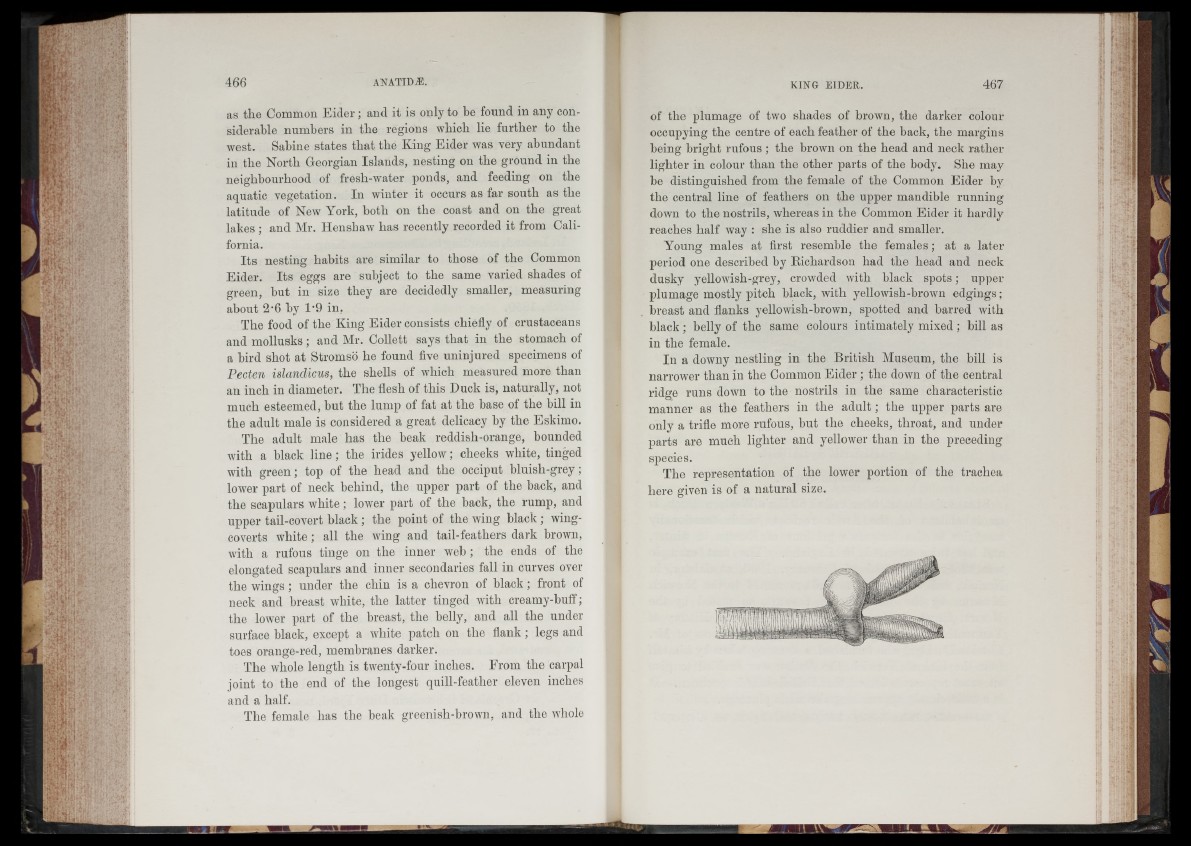
as the Common Eider; and it is only to be found in any considerable
numbers in the regions which lie further to the
west. Sabine states that the King Eider was very abundant
in the North Georgian Islands, nesting on the ground in the
neighbourhood of fresli-water ponds, and feeding on the
aquatic vegetation. In winter it occurs as far south as the
latitude of New York, both on the coast and on the great
lakes ; and Mr. Henshaw has recently recorded it from California.
Its nesting habits are similar to those of the Common
Eider. Its eggs are subject to the same varied shades of
green, hut in size they are decidedly smaller, measuring
about 2-6 by 1*9 in.
The food of the King Eider consists chiefly of crustaceans
and mollusks; and Mr. Collett says that in the stomach of
a bird shot at Stromso he found five uninjured specimens of
Pecten islandicus, the shells of which measured more than
an inch in diameter. The flesh of this Duck is, naturally, not
much esteemed, but the lump of fat at the base of the hill in
the adult male is considered a great delicacy by the Eskimo.
The adult male has the beak reddish-orange, bounded
with a black line; the irides yellow; cheeks white, tinged
with green; top of the head and the occiput bluish-grey ;
lower part of neck behind, the upper part of the hack, and
the scapulars white; lower part of the back, the rump, and
upper tail-covert black ; the point of the wing black; wing-
coverts white ; all the wing and tail-feathers dark brown,
with a rufous tinge on the inner web ; the ends of the
elongated scapulars and inner secondaries fall in curves over
the wings; under the chin is a chevron of black; front of
neck and breast white, the latter tinged with creamy-buff;
the lower part of the breast, the belly, and all the under
surface black, except a white patch on the flank ; legs and
toes orange-red, membranes darker.
The whole length is twenty-four inches. Erom the carpal
joint to the end of the longest quill-feather eleven inches
and a half.
The female has the beak greenish-brown, and the whole
of the plumage of two shades of brown, the darker colour
occupying the centre of each feather of the hack, the margins
being bright rufous; the brown on the head and neck rather
lighter in colour than the other parts of the body. She may
be distinguished from the female of the Common Eider by
the central line of feathers on the upper mandible running
down to the nostrils, whereas in the Common Eider it hardly
reaches half way : she is also ruddier and smaller.
Young males at first resemble the females ; at a later
period one described by Richardson had the head and neck
dusky yellowish-grey, crowded with black spots; upper
plumage mostly pitch black, with yellowish-brown edgings;
breast and flanks yellowish-brown, spotted and barred with
black; belly of the same colours intimately mixed; bill as
in the female.
In a downy nestling in the British Museum, the bill is
narrower than in the Common E ider; the down of the central
ridge runs down to the nostrils in the same characteristic
manner as the feathers in the adult; the upper parts are
only a trifle more rufous, but the cheeks, throat, and under
parts are much lighter and yellower than in the preceding
species.
The representation of the lower portion of the trachea
here given is of a natural size.